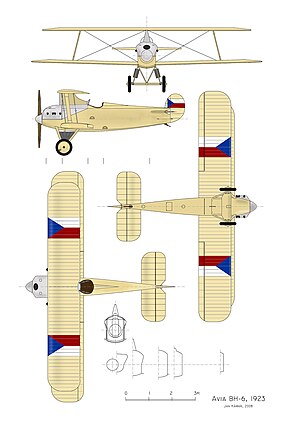Avia BH-6
Appearance
| BH-6 | |
|---|---|

| |
| Role | Fighter |
| Manufacturer | Avia |
| Designer | Pavel Beneš and Miroslav Hajn |
| First flight | 1923 |
| Number built | 1 |
The Avia BH-6 was a prototype fighter aircraft built in Czechoslovakia in 1923. It was a single-bay biplane of unusual configuration, developed in tandem with the BH-7, which shared its fuselage and tail design.
Development
The BH-6 had wings of unequal span, but unusually, the top wing was the shorter of the two, and while it was braced to the bottom wing with a single I-strut on either side, these sloped inwards from bottom to top. Finally, the top wing was attached to the fuselage not by a set of cabane struts, but by a single large pylon.
The BH-6 crashed early in its test programme, and when the related BH-7 did also, both implementations of this design were abandoned.
Specifications
General characteristics
- Crew: one pilot
Performance
See also
Related development
References
Wikimedia Commons has media related to Avia BH-6.
- Taylor, Michael J. H. (1989). Jane's Encyclopedia of Aviation. London: Studio Editions. p. 86.
- World Aircraft Information Files. London: Bright Star Publishing. pp. File 889 Sheet 86.
- Němeček, V. (1968). Československá letadla. Praha: Naše Vojsko.
- airwar.ru
